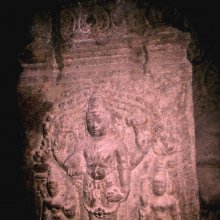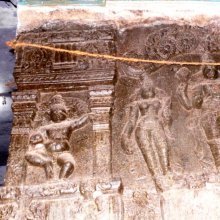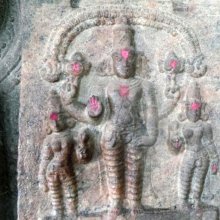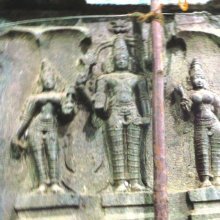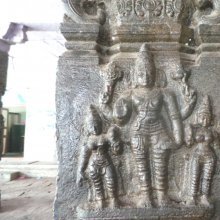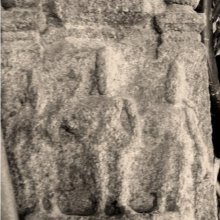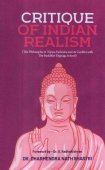Varadaraja, Varadarāja: 9 definitions
Introduction:
Varadaraja means something in Hinduism, Sanskrit, the history of ancient India. If you want to know the exact meaning, history, etymology or English translation of this term then check out the descriptions on this page. Add your comment or reference to a book if you want to contribute to this summary article.
Images (photo gallery)
(+4 more images available)
In Hinduism
Vastushastra (architecture)
Source: Shodhganga: Temples of Salem region Up to 1336 ADVaradarāja (वरदराज).—The Varadarāja temple is situated in Sendamangalam. This temple is datable to Vijayanagara period, i.e., 16th century. From the observation of the stylistic features, it can be concluded that the entire structure i.e., from the garbhagṛha to the gopura, was constructed at one time.
On elevation, this temple has upapīṭha, adhiṣṭhāna, bhitti, prastara and a superstructure of modem times. The entire structure, including the mukhamaṇḍapa and vāhanamaṇḍapa, is constructed over a pratibhadra-upapīṭha.
Upapīṭha: This upapīṭha has an upāna, padmajagati, broad gala with galapādas and a kapota moulding. The galapādas are relieved with floral designs, creeper scrolls etc. The surface of the kapota is decorated with elongated lotus petals.
Adhiṣṭhāna: The adhiṣṭhāna provided to the temple is of padmakesara variety. Though not omate, the execution of this plinth is delicate and neat. The minute padmadalas carved are very intricate. The kumuda of this adhiṣṭhāna is tripaṭṭa. The mouldings appear thinner than the usual adhiṣṭhānas and the gala also is narrow.
Bhitti: The bhitti is decorated mainly with architectural motifs and no reliefs of figural theme are noticed. The bhittipādas on the wall of the garbhagṛha and antarala are of brahmakānta type and those on the gūḍhamaṇḍapa wall are of the viṣṇukānta type.
Prastara: The prastara is simple in its form. The valabhi has a row of scalloped lotus petals relieved on its surface. The kapota is the regular quadrant shaped kapota. The vājana is decorated with the usual vyālamāla.
On plan, this temples possesses a garbhagṛha, antharala, ardhamaṇḍapa, gūḍhamaṇḍapa and a mahāmaṇḍapa.

Vastushastra (वास्तुशास्त्र, vāstuśāstra) refers to the ancient Indian science (shastra) of architecture (vastu), dealing with topics such architecture, sculpture, town-building, fort building and various other constructions. Vastu also deals with the philosophy of the architectural relation with the cosmic universe.
Shilpashastra (iconography)
Source: Archaeological Survey of India: Śaiva monuments at Paṭṭadakal (śilpa)Varadarāja (वरदराज).—Viṣṇu in Varada pose is found as a sculpture at the temple of Lokeśvara, western pillar in the northern entrance, northern face.—The personage with four hands, holding conch and discus, without hesitation, can be identified with Viṣṇu. Besides, his attire and other ornamentations also suit the personality of Viṣṇu. He is in varada, benediction pose, to the person, dressed like a mendicant, standing there holding a begging bowl in his hands. Although, he is depicted with only two hands, his facial features and other factors like a matted hair on the summit of his head, no other cloth except a kaupīna to hide his privities etc. make us to identify him with Śiva.

Shilpashastra (शिल्पशास्त्र, śilpaśāstra) represents the ancient Indian science (shastra) of creative arts (shilpa) such as sculpture, iconography and painting. Closely related to Vastushastra (architecture), they often share the same literature.
Vyakarana (Sanskrit grammar)
Source: Wikisource: A dictionary of Sanskrit grammarVaradarāja (वरदराज).—A scholar of grammar and a pupil of Bhattoji Diksita who flourished in the end of the seventeenth century and wrote abridgments of the Siddhanta-kaumudi for beginners in grammar named लघुसिद्धान्तकौमुदी (laghusiddhāntakaumudī) and मध्यसिद्धान्तकौमुदी (madhyasiddhāntakaumudī) as also धातुकारिकावली (dhātukārikāvalī) and गीर्वाणपदमञ्जरी (gīrvāṇapadamañjarī). The work under the name सार-सिद्धान्तकौमुदी (sāra-siddhāntakaumudī), which is the shortest abridgment, is, in fact, the लघु-सिद्धान्तकौमुदी (laghu-siddhāntakaumudī) itself. It is possible that the auother first prepared the सार-सिद्धान्तकौमुदी (sāra-siddhāntakaumudī) and then, he himself or a pupil of his, put additional necessary matter and prepared the Laghusiddhanta-kaumudi.

Vyakarana (व्याकरण, vyākaraṇa) refers to Sanskrit grammar and represents one of the six additional sciences (vedanga) to be studied along with the Vedas. Vyakarana concerns itself with the rules of Sanskrit grammar and linguistic analysis in order to establish the correct context of words and sentences.
Nyaya (school of philosophy)
Source: Shodhganga: A study of Nyāya-vaiśeṣika categoriesVaradarāja (वरदराज) flourished about 1150A.D. He wrote a commentary called Bodhinī on Udayana’s Nyāyakusumāñjalī. He also wrote an independent work which is called Tārkikarakṣā. There are three chapters in the Tārkikarakṣā. In the first chapter the first fourteen categories accepted in Nyāyasūtra. In the second chapter, there is found the fifteenth category, viz. jāti and in the third chapter, the sixteenth category, i.e. nigrahasthāna. Varadarāja combines the six categories of the Vaiśeṣika Philosophy, viz. dravya, guṇa, karma, sāmānya, viśeṣa and samavāya with the prameya of the Nyāyasūtra. He himself wrote a commentary on this work named Sārasaṃgraha.

Nyaya (न्याय, nyaya) refers to a school of Hindu philosophy (astika), drawing its subject-matter from the Upanishads. The Nyaya philosophy is known for its theories on logic, methodology and epistemology, however, it is closely related with Vaisheshika in terms of metaphysics.
General definition (in Hinduism)
Source: academia.edu: Tessitori Collection I (hinduism)Varadarāja (वरदराज) is the author of the Tārkikarakṣā (dealing with Philosophy), which is included in the collection of manuscripts at the ‘Vincenzo Joppi’ library, collected by Luigi Pio Tessitori during his visit to Rajasthan between 1914 and 1919.—The Tārkikarakṣā (“protection of Reasoning”) was written by Varadarāja in the middle of the 12th century CE. It is a representative of the old nyāya school. In the part available in this manuscript the author discusses the importance of pramāṇa and gives statements about how they are viewed by other schools: the Buddhists (Saugata), the materialists (Cārvāka) and Vaiśeṣika (Kaṇāda), Mīmāṃsā (Prabhākara), and the Paurāṇika. It is interesting to see that this non-Jain text follows a philosophical work by Hemacandra and is found in Jain libraries, but not surprising as logic tends to transcend religious boundaries.
India history and geography
Source: Knowledge Traditions & Practices of India: Painting: A Survey (h)Varadaraja temple (at Kanchipuram) is an archaeologically important site containing ancient Indian mural paintings, from the Vijayanagara period.

The history of India traces the identification of countries, villages, towns and other regions of India, as well as mythology, zoology, royal dynasties, rulers, tribes, local festivities and traditions and regional languages. Ancient India enjoyed religious freedom and encourages the path of Dharma, a concept common to Buddhism, Hinduism, and Jainism.
Languages of India and abroad
Sanskrit dictionary
Source: Cologne Digital Sanskrit Dictionaries: Aufrecht Catalogus Catalogorum1) Varadarāja (वरदराज) as mentioned in Aufrecht’s Catalogus Catalogorum:—a philosophical writer. K. 72.
2) Varadarāja (वरदराज):—Kavijanavinoda.
3) Varadarāja (वरदराज):—Kiraṇāvalīṭīkā.
4) Varadarāja (वरदराज):—Tattvanirṇaya, vedānta.
5) Varadarāja (वरदराज):—Tarkakārikāḥ. Hall. p. 27. This is the next work. Tārkikarakṣā. Sārasaṃgraha, a
—[commentary] on the Tārkikarakṣā. No doubt, the Sārasaṃgraha by Varajit Varadarāja, which in Oppert. 1057. Ii, 6154 is turned into a vocabulary, belongs hither.
6) Varadarāja (वरदराज):—Nyāyadīpikā.
7) Varadarāja (वरदराज):—Puruṣasūktabhāṣya.
8) Varadarāja (वरदराज):—Pramāṇapadārtha [grammatical]
9) Varadarāja (वरदराज):—Bhāṣāmañjarī [grammatical]
10) Varadarāja (वरदराज):—Mandasubodhinī, a
—[commentary] on Ānandatīrtha’s Mahābhāratatātparyanirṇaya.
11) Varadarāja (वरदराज):—Yāgaprāyaścittavyākhyā.
12) Varadarāja (वरदराज):—Vyavahārakāṇḍa or Vyavahāranirṇaya. Vyavahāramālā. Varadarājīya [dharma] Oppert. 809. 2026. 3206. 3848. 4049. 4644. 5154. 5304. 6530. 8229. Ii, 412. 4915. 5260. 5559. 6414. 6949. 7733. 8939. 9651.
—[commentary] Ii, 4916.
13) Varadarāja (वरदराज):—Śivasūtravārttika.
14) Varadarāja (वरदराज):—son of Durgātanaya: Gīrvāṇapadamañjarī, grammar. Madhyasiddhāntakaumudī. Laghusiddhāntakaumudī or Laghukaumudī. Sārasiddhāntakaumudī or Sārakaumudī.
15) Varadarāja (वरदराज):—son of Raṅgarāja, grandson of Devarāja, pupil of Sudarśanācārya: Mīmāṃsānayavivekadīpikā.
16) Varadarāja (वरदराज):—son of Rāmadevamiśra: Nyāyakusumāñjaliṭīkā, notes on Haridāsa’s Commentary.
17) Varadarāja (वरदराज):—son of Vāmanācārya, grandson of Anantanārāyaṇa: Ṛgvedabhāṣya. Taittirīyāraṇyakabhāṣya. Nidhanasūtravṛtti. Pratihārasūtravṛtti. Maśakakalpasūtrabhāṣya. Varadarājadīkṣitīya śr. Oppert. Ii, 5259.
18) Varadarāja (वरदराज):—Saṃskṛtamālā.
19) Varadarāja (वरदराज):—son of Raṅganātha, seventh in descent of Devarāja. He was a pupil of Sudarśanācārya: Vivekadīpikā, a C. on Bhavanātha’s Mīmāṃsānayaviveka.
Source: Cologne Digital Sanskrit Dictionaries: Monier-Williams Sanskrit-English DictionaryVaradarāja (वरदराज):—[=vara-da-rāja] [from vara-da > vara] m. (also with ācārya, colapaṇḍita, bhaṭṭa, bhaṭṭāraka) Name of various authors and other persons, [Catalogue(s)] (-campū f. -daṇḍaka m., -pañcāśat f. -maṅgala n., -mahiṣī-stotra n. -mūla n. -śataka n. -su-prabhāta m., -stava m. -stotra n.; jāṣṭaka n. jāṣṭottara-śata n. Name of works.; jīya mfn. coming from or relating to or composed by Varada-rāja; n. Name of [work])
[Sanskrit to German]
Sanskrit, also spelled संस्कृतम् (saṃskṛtam), is an ancient language of India commonly seen as the grandmother of the Indo-European language family (even English!). Closely allied with Prakrit and Pali, Sanskrit is more exhaustive in both grammar and terms and has the most extensive collection of literature in the world, greatly surpassing its sister-languages Greek and Latin.
See also (Relevant definitions)
Partial matches: Varada, Raja.
Starts with: Varadaraja acarya, Varadaraja bhatta, Varadaraja bhattaraka, Varadaraja colapandita, Varadaraja dikshita, Varadarajacampu, Varadarajadandaka, Varadarajamahishistotra, Varadarajamangala, Varadarajamula, Varadarajapancashat, Varadarajashataka, Varadarajashtaka, Varadarajashtottarashata, Varadarajastava, Varadarajastotra, Varadarajasuprabhata, Varadarajasuprabhatashtaka, Varadarajavasantotsava.
Full-text (+59): Vitikanthirava, Laghukaumudi, Varadarajiya, Tarkikaraksha, Madhyasiddhantakaumudi, Girvanapadamanjari, Madhyakaumudi, Sarasiddhantakaumudi, Pratiharasutra, Vivekatilaka, Varadaraja acarya, Varadaraja dikshita, Yagaprayashcittavyakhya, Pramanapadartha, Samnyasapadamanjari, Varadaraja bhattaraka, Samasutravyakhya, Nidhanasutravritti, Varadaraja bhatta, Ahinakalpavyakhya.
Relevant text
Search found 26 books and stories containing Varadaraja, Varadarāja, Varada-raja, Varada-rāja; (plurals include: Varadarajas, Varadarājas, rajas, rājas). You can also click to the full overview containing English textual excerpts. Below are direct links for the most relevant articles:
Tiruvaymoli (Thiruvaimozhi): English translation (by S. Satyamurthi Ayyangar)
Pasuram 4.7.5 < [Section 7 - Seventh Tiruvaymoli (Cilam illac ciriyan)]
Pasuram 1.8.4 < [Section 8 - Eighth Tiruvaymoli (Otum pul eri)]
Pasuram 1.6.9 < [Section 6 - Sixth Tiruvaymoli (Parivatu il icanai)]
The validity of Anumana (inference) in Nyaya system (by Babu C. D)
Chapter 4.2.2 - The Prakaranas (b): Tarkikaraksha by Varadaraja
Later Chola Temples (by S. R. Balasubrahmanyam)
Temples in Sarkar Periyapalayam < [Chapter IV - Temples of Vikrama Chola’s Time]
Temples in Kanchipuram < [Chapter IV - Temples of Vikrama Chola’s Time]
Temples in Kanchipuram < [Chapter XII - Temples of Kulottunga III’s Time]
Siddhanta Sangraha of Sri Sailacharya (by E. Sowmya Narayanan)
Middle Chola Temples (by S. R. Balasubrahmanyam)
Temples in Tirumukkudal < [Adhi Rajendra Tiruvakkarai]
Temples in Tiruvakkarai < [Chapter II - Temples of Rajaraja I’s Time]
Temples in Tribhuvani < [Rajadhiraja I]
Temples in and around Madurantakam (by B. Mekala)
Sri Varadaraja Perumal Temple < [Chapter 3 - Temples of Madurantakam Taluk]
Sri Vijaya Varadaraja Perumal Temple < [Chapter 3 - Temples of Madurantakam Taluk]
Sri Varadaraja Perumal Temple < [Chapter 3 - Temples of Madurantakam Taluk]
Related products
